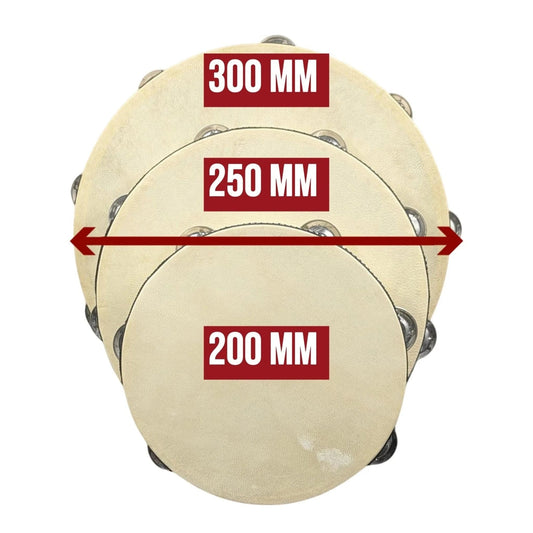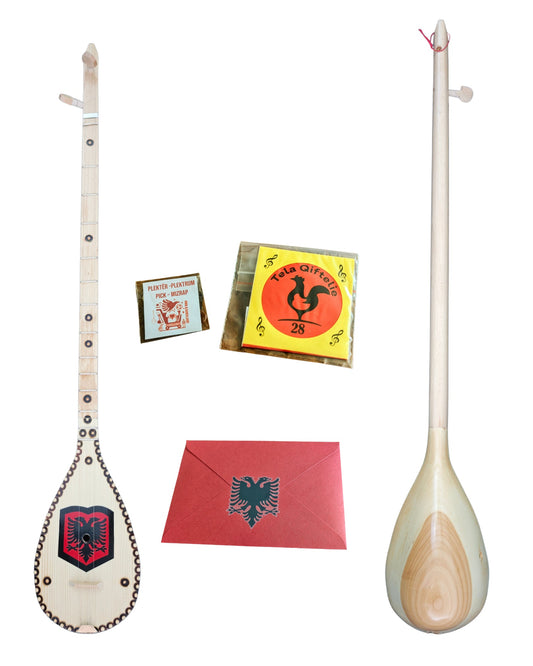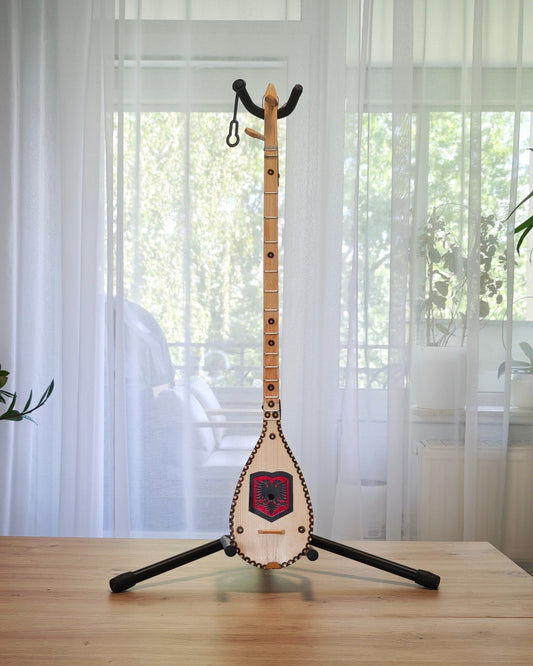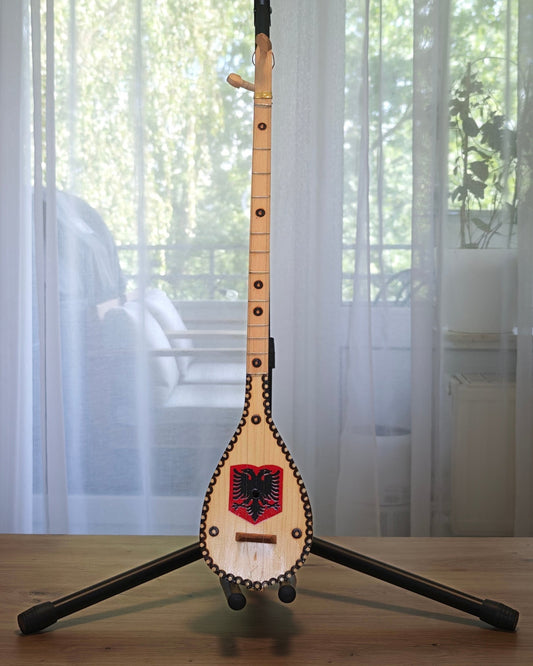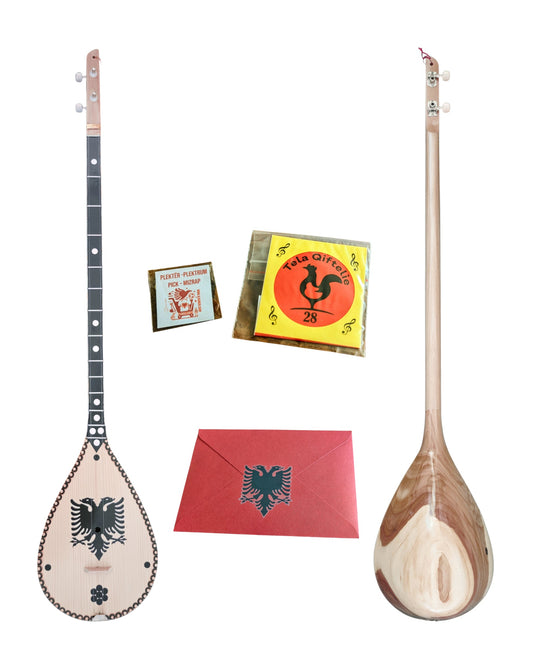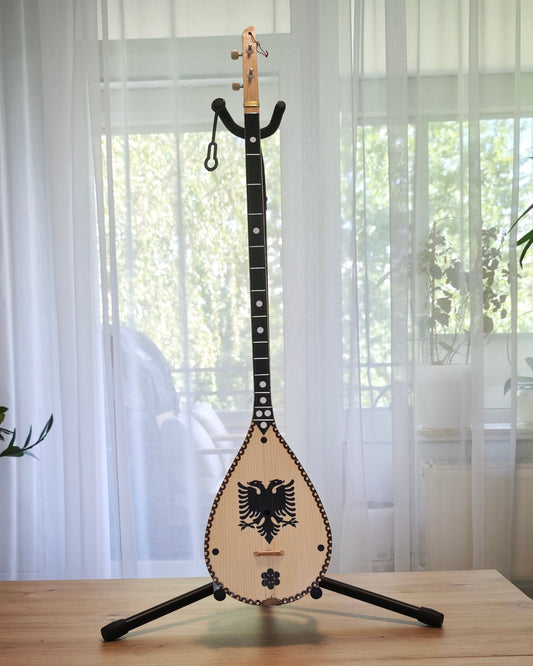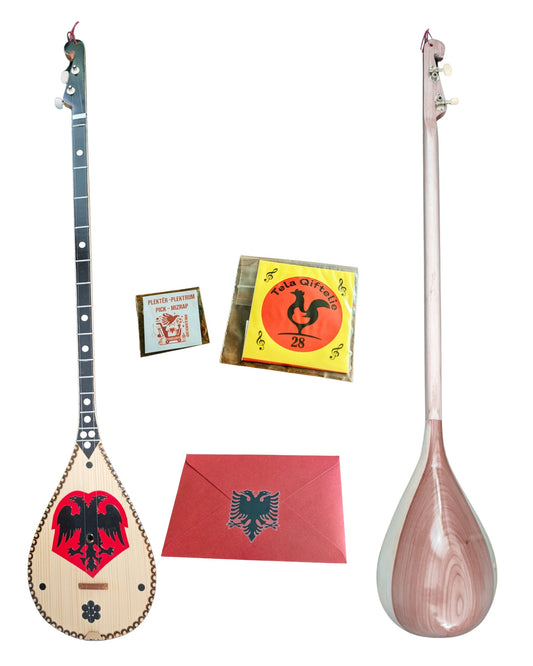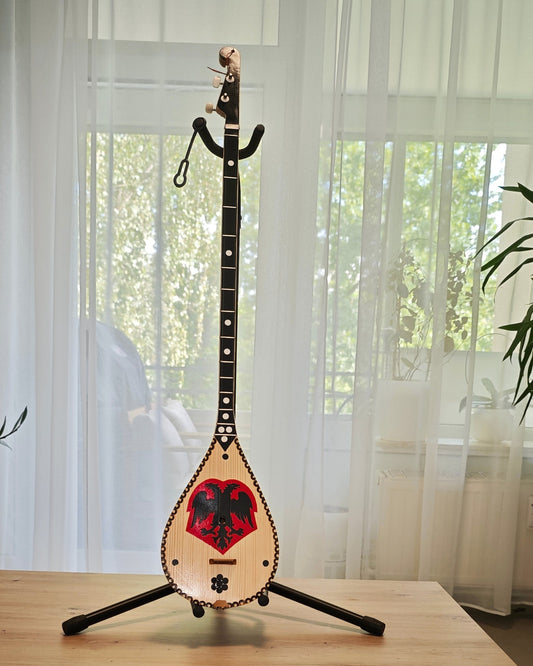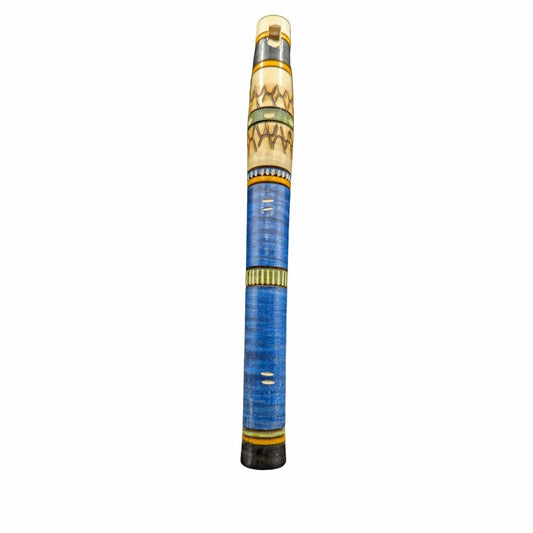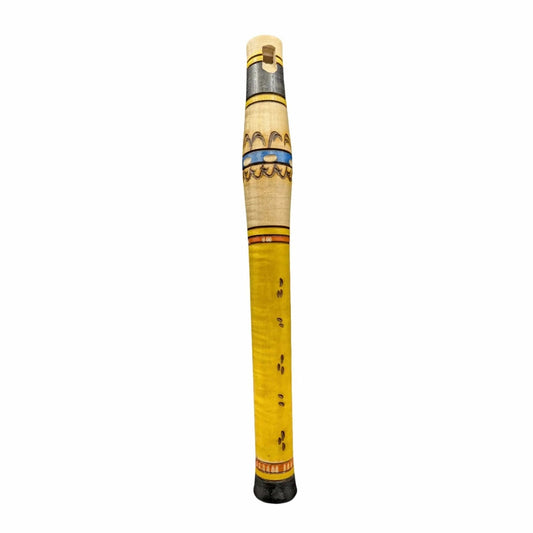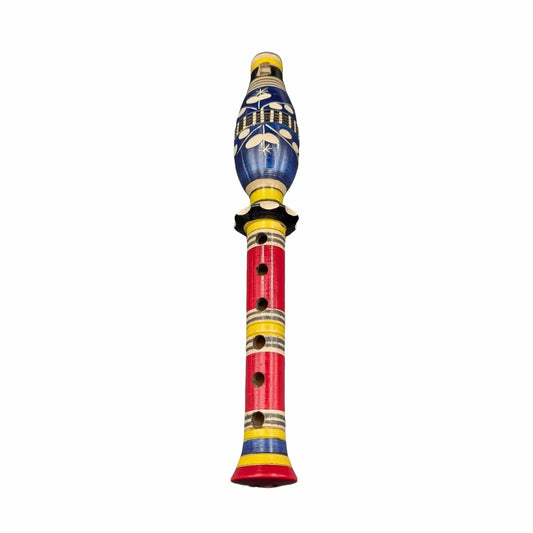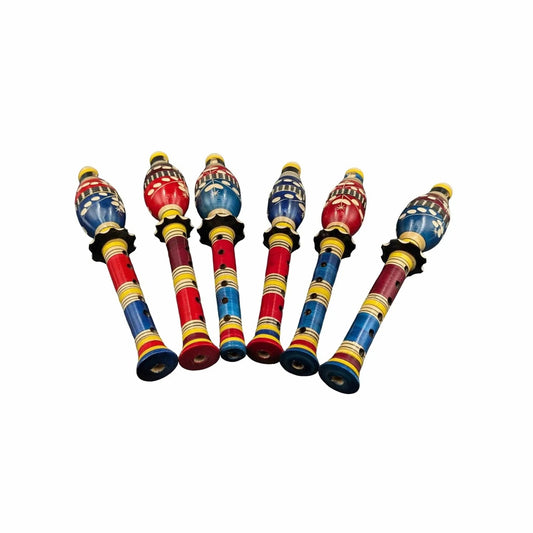-
Def / Dahire in different sizes
Regular price From €14,99 EURRegular price -
Handmade Qifteli, perfect for traditional music (M, approx. 80 cm)
Regular price €84,99 EURRegular price€79,99 EURSale price €84,99 EURSold out -
Handmade Qifteli, perfect for traditional music (S, approx. 65 cm)
Regular price €59,99 EURRegular price€59,99 EURSale price €59,99 EURSold out -
Handmade Qifteli, perfect for traditional music (L, approx. 93 cm)
Regular price €139,99 EURRegular price€149,99 EURSale price €139,99 EURSold out -
Handmade Qifteli, perfect for traditional music (XL, approx. 100 cm)
Regular price €169,99 EURRegular price€199,99 EURSale price €169,99 EURSale -
Traditional Balkan Wooden Flute Narrow
Regular price €11,99 EURRegular price -
Traditional Balkan wooden flute wide
Regular price €12,99 EURRegular price
Collection: Instruments
Instruments – Qifteli, Def & Flutes from the Balkan Tradition
Welcome to our Instruments category – here you'll find hand-picked musical instruments from the Albanian and Balkan tradition: the two-stringed Qifteli (available in several sizes), the frame-based Def drum, and wooden flutes for that characteristic, warm Balkan sound . Whether you're playing your first melodies, accompanying family celebrations and weddings, or want to own an authentic piece of culture as a collector – this collection combines sound , craftsmanship , and history .
Why these instruments are special
Each instrument was selected for playability , durability , and authentic timbre . The two-stringed qifteli delivers distinctive, present melodies—perfect for traditional songs from Albania and Kosovo . The def (also called daf/daire) sets driving rhythms with variable beats, buzzing, and tonal effects. Wooden flutes bring the bright, clear voice of shepherd and dance music. All models are crafted for everyday use: sturdy woods, clean edges, and pleasantly tactile surfaces—making practicing, rehearsing, and performing a pleasure.
🎶 Who is the “Instruments” category suitable for?
Beginners seeking direct access to Balkan melodies and wanting to start with a straightforward instrument. Advanced players seeking to expand their sound with an authentic setup. Ensembles and clubs accompanying weddings, cultural evenings, and festivals. Collectors who value craftsmanship, regional origins, and harmonious details.
Qifteli – the two strings with great character
The qifteli (also spelled Çiftelia ) is a two-stringed plucked instrument native to Kosovo, northern Albania, and parts of North Macedonia. Its sound is bright, direct, and carries well in groups. It is traditionally played with a plectrum, often with fast, rhythmic articulation for dance pieces—but singable, lyrical lines are also typical. Our range includes the qifteli in several lengths—from S to XL —so you can find the right scale length for your hand size, playing feel, and stage effect.
📏 Sizes & feel: S, M, L, XL
- S (approx. 65 cm) – short, lightweight, ideal for teenagers, small hands, or as a travel/session instrument. Quick grip, agile action.
- M (approx. 80 cm) – balanced standard size: comfortable scale length, clear intonation, good balance of carrying capacity and handling.
- L (approx. 93 cm) – longer and fuller in tone, more sustain; popular with players who prefer a slightly "larger" fingerboard.
- XL (approx. 100 cm) – presence on stage, full projection, striking look; ideal for solo features and large rooms.
Tip: If you're on the go a lot or play a lot while sitting down, M often feels most natural. For recording and stage, L and XL offer extra carrying capacity.
🎼 Tuning, pick & technique
In practice, open tunings are preferred, allowing for fast patterns and drone effects. Many players use a medium-thick pick (0.7–1.0 mm) for a defined attack without too much "click." Alternate attacks , trills , and slide ornaments are typical. For Balkan dances, accents can be quite distinct—the qifteli can "lead."
🛠️ Construction & Maintenance
Our Qifteli are made of sturdy wood with neatly glued sides and smooth fingerboard edges. Care: Wipe dry after playing, protect from excessive heat and humidity, and change strings regularly (for a fresher sound and better intonation). We recommend a padded bag for transport.
Def – Rhythm giver for dance & tradition
The Def is a frame drum with a tightly stretched head. It delivers a wide range of sounds, from a gentle pulse to an energetic groove – through finger, palm, rim, and tapping techniques. In ensembles, the Def holds pieces together, emphasizes transitions, and instantly creates a festive atmosphere.
🥁 Game tips & sounds
For low, basic hits, use the palm of your hand near the center of the drumhead; edge hits add high notes and define the pulse. Finger rolls and ghost notes create flowing patterns. If you like, you can use jingle rings (depending on the model) to create additional glittering textures.
🧰 Care & Handling
Keep the head dry and protect it from extreme moisture. After the gig, air it out briefly, then store it in the case. Wipe away any light dust with a dry, soft cloth. Keep an eye on the head tension during temperature fluctuations; small changes will affect the feel—this is normal and part of the Def character.
Traditional wooden flutes – clear melody, warm breath
Our Balkan wooden flutes – in narrow and wide bores – cover a wide spectrum, from bright, pastoral melodies to sustaining, danceable lines. The narrow bore sounds focused and brilliant; the wide version carries a somewhat fuller, slightly darker timbre. Ideal for solos, for dialogues with qifteli, or as a contrast to the deft.
🎯 Beginner-friendly & flexible
Simple fingering, direct blowing, and low maintenance make wooden flutes perfect instruments for beginners . At the same time, advanced players benefit from their expressiveness: bending , vibrato , dynamic bows, and articulation via the tongue/palate—the expressive possibilities are astonishingly broad.
🌲 Wood & Care
Depending on the model, hard, sturdy woods are used. Occasionally treat flutes with a small amount of suitable oil (according to the manufacturer's instructions) to prevent cracking; allow them to dry briefly after playing. Avoid large temperature changes (e.g., freezing cold → heating air).
Outlook: further instruments in planning
We're continually expanding the category. Planned additions include the lahuta (a traditional, bowed , single-stringed instrument), the kaval (open-rim flute with a soft, earthy tone), further variations of the Çiftelia/Qifteli , percussion (frame and hand drums, small effects), and accessories such as bags, stands, picks , and possibly microphone clips for stage and recording. If you're looking for a specific instrument, please give us feedback – we'll align our procurement with the community.
Typical fields of application
- Weddings & family celebrations: Qifteli + Def as groove team, flute for melody/answer
- Cultural and club evenings: solo features, small acoustic ensembles, storytelling concerts
- School & Workshops: Introduction to rhythm/melody, intercultural music education
- Studio & Content: characterful overdubs, social reels, live sessions
🎤 Microphones & Stage
Qifteli: Place a condenser microphone slightly to the side of the sound hole (20–30 cm). Live, ideally combined with a piezo/clip mic. Def: Place a distance of 10–20 cm from the front, varying the angle slightly depending on the bass/treble content. Flute: Place it to the side of the labium/blowing hole, not directly into the airstream; this keeps the sound soft and natural.
Matching accessories & useful bundles
- Qifteli + Bag + Pick Set: Protection & consistent playing feel
- Def + cover + micro clip: quickly ready to play, suitable for the stage
- Flute + cleaning kit + soft case: easy care, safe storage
- Instrument + sheet music/tab guide: quick start, motivation boost
Quality & selection criteria
We test instruments for intonation , ergonomics , material quality , and sound consistency . Fingerboard edges, frets, glued joints, and surfaces are inspected. With flutes, we pay attention to clean blowing response and balanced registers; with defts, we check for head tension and dynamic stability. This way, you can be sure: If it says "active" here, the instrument is ready for rehearsals, performances, and lessons.
FAQ – Frequently asked questions about our instruments
Which Qifteli size should I choose?
S for kids, small hands, or as a travel instrument; M as the all-around standard; L/XL for more presence and sustain. If you're unsure, start with M —it fits most players perfectly.
Is the Def suitable for beginners?
Yes. Basic patterns are easy to learn, and you can gradually progress to more complex patterns. A major advantage of the Def: It works equally well solo and in an ensemble .
Which flute is better: narrow or wide?
Narrow bore = focused, slightly brighter; wide bore = fuller, slightly darker. For beginners, the narrow bore is often a bit easier to pick up; for expressive solos, many prefer the wide version.
Do I need to know how to read music?
Not necessarily. Many traditional pieces are learned by ear. Tabs, chord diagrams, and simple audio loops help you get started. If you like, you can add notes/modes later.
How do I care for my instrument in the long term?
Protect from moisture and heat, wipe dry after playing, and store in suitable cases . Oil flutes occasionally (according to manufacturer's instructions), change the strings on the qifteli, and avoid over-tightening the def head—this will ensure consistent sound and feel for years to come.
Music with context – why traditional instruments are relevant today
Traditional Albanian instruments connect generations: grandparents recognize melodies, children learn rhythm and hearing, communities celebrate shared roots. At the same time, qifteli, def, and wooden flutes are contemporary —they function in acoustic pop, world music, film sound, and social content. Anyone who has ever experienced a qifteli melody floating over a def groove and a flute singing the answer understands: This is more than nostalgia—it's living the present .
💡 Practical ideas for teaching & community
School: simple call-and-response motifs, def ostinatos, flute drones for breathing training.
Club: Repertoire evenings with changing solos, family workshops (rhythm + melody).
Recording: short Qifteli hooks as loops; flute layers for intros; mixing def patterns with handclaps.
Conclusion – authentic instruments, inspiring possibilities
Whether you're taking your first steps, revitalizing an old repertoire, or looking for a distinctive live setup, our Qifteli , Def , and wooden flutes are powerful, reliable partners. They're a perfect fit for living room sessions, on stage, in clubs, studios, and even in your travel bag. Discover instruments that carry history—while simultaneously shaping your sound today.


